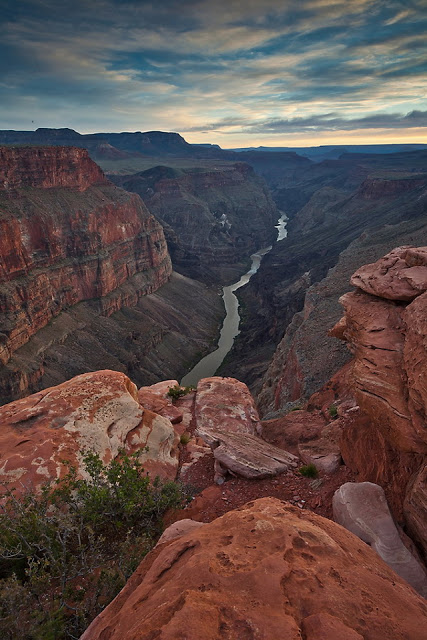I admire those that can capture the canyon with paint, pastel, music or film. But the canyon is also story and poetry and prose. It is the narrative of mountains and oceans and ferns and cacti, of kivas and catacombs, of things here, and things gone. It is the tale of water, and change, and storms that carry sediment, and walls that cleave sunlight. It is natives sharing stories from mouth to ear, and handprints on a wall saying remember. Formations like Zoroaster Granite, Vishnu Schist, and Cremation Pegmatite must have been named by poets—people who understood the magic and influence of words and who wanted others to understand that when we speak of the forces that shape the canyon, we speak of greater powers.
The first time I saw the Grand Canyon it was from its base. Starting at Lee’s Ferry I entered the canyon’s marble gateway, gliding through its waters deeper and deeper into time. Kaibab, Toroweap, Muav, Tapeats. It was autumn, 1996, and I was on an 18 day self-supported trip. I was a geologist, turned environmental educator turned mediator turned journalist. Just prior to launch, I had spent several days at the Oregon State Penitentiary covering a story for National Public Radio on the first execution of an Oregon prisoner in more than 30 years. The assignment left me drained and confused, obsessed about questions of right and wrong and the choices we make.
As a writer and geologist, I was in my element floating between those walls. As a human, I was not. This is a land that dwarfs intentions. “Nothing is permanent,” the water murmurs. “Nothing lasts. All is change and all is dust and all is all that all is.” Nearly two billion years of life compressed into a mile of cliffs gives one pause, and then catapults the mind to new dimensions; spaces not trapped by the priorities of the “rim world” but expanded by the daily activities of a life lived well, in the moment, riffle by riffle.
After my experience on the Colorado, I demanded more from myself and my work, hoping to make my speck of life count for something to someone. My reports took on issues of personal importance: the environment, endangered species, education, justice. And I began to win awards. But after a bout with cancer, I gave up my career as a reporter and started to write for a different audience. My essays have appeared in The Washington Post, The Oregonian and The Guardian as well as Literary Journals such as The LA Review. And my novel, The Crying Tree, is an international best seller and a winner of the Pacific Northwest Booksellers Award. The Crying Tree is a literary novel set in both Southern Illinois and the high desert of Central Oregon, and is about the emotional and physical landscapes a family must traverse as they deal with the murder of their child and the impending execution of his killer. Foremost, however, the book is about the transforming forces of fear, hate and forgiveness.
The Crying Tree was drawn from my background in geology and journalism, my years spent with tribes, ranchers and farmers mediating conflict and teaching ways to manage land sustainably, and from my trip down the Grand Canyon that taught me there is nothing more forgiving than time.
The opportunity for the Artist-in-Residence program comes at a particularly good point in my life as this summer I will, once again, raft the Grand Canyon. Like my previous journey, I intend to spend much of my time hiking, taking photographs and writing. My goal, whether writing fiction, poetry, prose or non-fiction, is to create narratives that live beyond the page, evoking emotion, connection and empathy for characters and setting. Story is an art form as well as a platform to teach. As an Artist-in-Residence at Grand Canyon National Park, I will use my experience teaching both natural resource management and writing to create opportunities for guests to hear stories that combine the richness of our external landscape, with all its beauty and texture, with the landscape of our inner lives.
-Naseem Rakha 3/31/12

Poetic! You inspire me to focus more on writing rather than work to get to a point where I can write. I'm sure your time at the Grand Canyon retreat will generate even more powerful works. Congratulations!
I loved The Crying Tree and look forward to hearing how your experience in the Grand Canyon influences your next work. Many of us are in those "taffy years" and trying to reclaim ourselves separate from wife, daughter, mother, neighbor, housekeeper, caretaker, gardener, etc. What a beautiful place to focus on what you love. Looking forward to more….
Its a good example of an essay that you have putted on your content. Many good writers will surely appreciate what you have posted here because this was full of a unique and relevant things in writing a different forms of essay that could look very different.
best professional proofreading service.